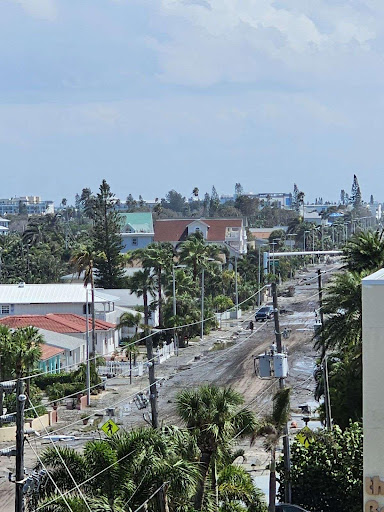
Regarded as one of the most destructive hurricanes to hit the United States, Hurricane Helene has ravaged communities in the southeastern United States from September 24 to September 29. A category 4 monstrosity, Helene has resulted in the highest death toll since 2005’s Katrina.
Hurricane Helene began as a powerful tropical storm in Florida’s Gulf Coast, making landfall as a Category 4 hurricane on September 26. With a record-breaking storm surge reported to be over 15 feet, Helene caused massive amounts of destruction along the Big Bend region of Florida. Helene traveled to Georgia as a Category 2 and released almost 15 inches of downpour, which led to dangerously high levels of flooding. Weakened to a tropical storm, Helene moved on to torment parts of North and South Carolina, as well as parts of Tennessee. Floating debris, flipped over vehicles, and washed away homes suggest years will be needed to restore towns in this area. In addition, over one million people lost power, including hundreds of thousands in Virginia. Over one hundred civilian deaths were reported, mostly due to flooding. First responders, such as firefighters, were also killed. Authorities still do not know the total death toll because of uncertainty regarding mountainous communities. Hurricane Helene became a tropical depression on Friday, September 27, and dissipated by Saturday.
Unfortunately, the severity of Hurricane Helene will not be the worst to come, as climate change will continue to heat up the ocean waters that directly affect tropical storms. Helene formed over abnormally warm waters in the Gulf of Mexico, and grew from a Category 1 to a Category 4 in a matter of days. The hot sea surface temperature resulted in high amounts of moisture in the air, which gave the potential for heavy rain. Additionally, the hurricane was massive, around 400 miles, and one of the largest to make landfall in the United States. Helene maintained its size as it traveled, and almost half of the death toll is from the more inland states, like North Carolina. It is likely that North Carolina experienced this due to its mountainous topography. Mountains typically receive more rainfall, so the river levels were able to rise quicker. North Carolina had already received large amounts of rainfall prior to Helene, so the ground was already saturated and the storm did not weaken at the pace it would have over drier land. There have been almost one hundred deaths related to Hurricane Helene in North Carolina alone.
In response to this tragedy, Brookfield Central’s Key Club hosted a Miracle Minute. Students donated to the American Red Cross for Hurricane Helene relief and contributed $3,014 as a whole. Key Club executive member, River Foy, describes the Miracle Minute as important to the culture at Brookfield Central because, “we need to sympathize with the millions of people struggling. Just because our geographical location wasn’t affected does not mean we can or should ignore it.” Maadhav Karun, also an executive member, agrees that it is essential for students at BC to be aware of real world events such as Hurricane Helene, saying, “we need to be aware because it’s affecting our country. We play a key role in helping citizens in damaged areas by fundraising. We raised over $3,000 in just one day. If we think of how much other schools could raise, high school students could really help with hurricane relief, as well as other unforeseen circumstances in the future.”
As Americans in the Southeast attempt to recover from Hurricane Helene, it is clear that it will not be the end of a difficult storm season. Hurricane Milton suggests to cause even more destruction than its predecessor. The age of global warming will result in new, inconsistent weather patterns. The contribution by students at BC helps both those directly affected, but also keeps our own community connected to the rest of the country.



